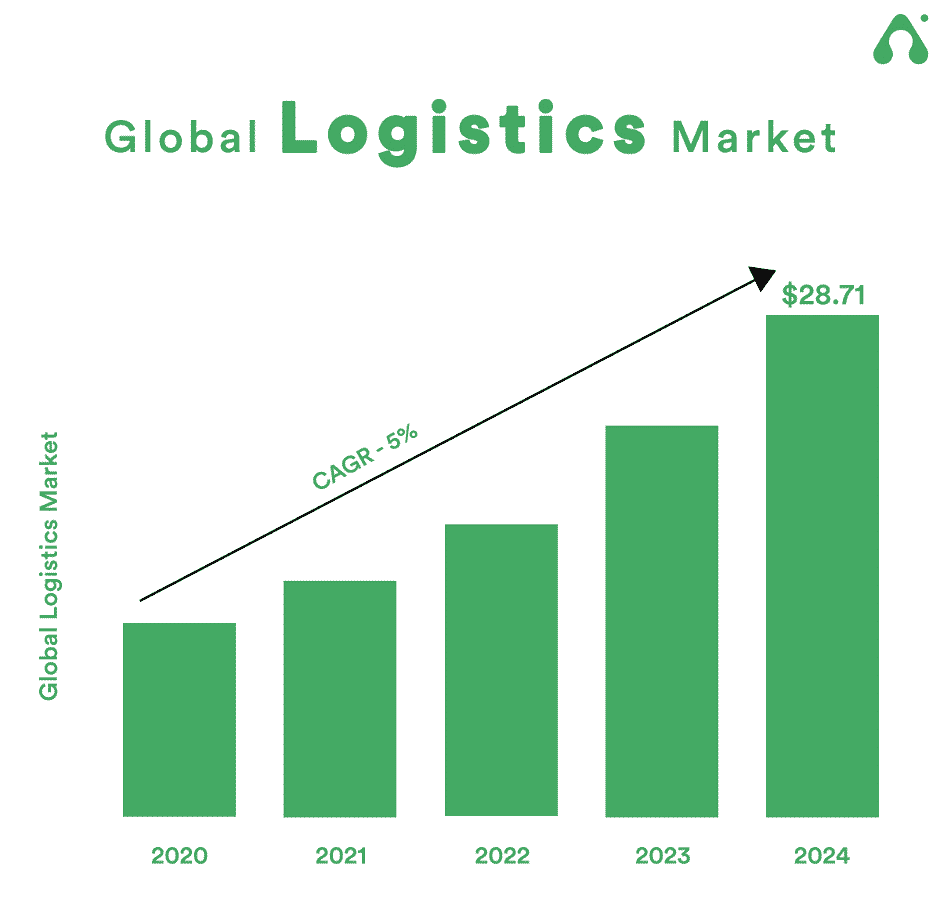Logistics app development is extremely proficient nowadays. The global logistics market evolves and according to forecasts from MarketWatch, it’ll grow by $28.71m by 2024.

This determines logistics app development as a business branch with a high ROI. It’s also important to note, that most logistics companies now are using software services to improve their workflow. The high-quality software solution can improve warehouse management, supply chain, and other aspects of this business.
You will have to find a reliable development partner and a tech stack that will benefit your business. This article will tell you how to do it.
The best technologies for logistics app development
Among the wide variety of programming languages, frameworks, and other tools for logistics app development we would like to tell about the few that might fit the best.
1. Flutter
Flutter is a cross-platform solution that allows the development of web apps, as well as Android, iOS, Windows, and applications for other OSs.
For web logistics app development, Flutter has one crucial benefit; it doesn’t use HTML, JavaScript, or CSS for styling so in every browser the app looks the same as when it was created.
It’s a great solution for mobile logistics app development because Flutter uses a single codebase for all platforms. Since it’s a cross-platform solution, you basically get applications for different platforms in one go. It’s also extremely cost-effective in terms of testing teams.
2. Node.js
Node.js is an open-source JavaScript environment that is used to develop server-side web applications. It’s perfect for large-scale applications, streaming websites, and single-page applications. But since it is compatible with lots of programming languages, it can be used for any other solution as well.
For logistics app development, Node.js benefits can change the game. It’s fast and allows to maintain lots of operation on the browser side. It also allows to handle user requests and fasten up the speed of a server’s response. With Node.js logistics app development, you’ll be able to improve the traffic capacity of your application and scale even quicker than you planned.
3. JavaScript
JavaScript is a programming language that is quick and can run within the client-side browser. It reduces that demand on the application/website server and helps the logistics app function in any circumstances.
The interface is also extremely important in development, and JavaScript can deliver. So, if you need a fast and good-looking logistics application, this is what you’re looking for.
Now, let’s find out how you can make your logistics app development even more cost-effective and efficient with the right development partner!
Outsource/Outstaff vs. an in-house logistics app development
When it comes to the model of cooperation, the choice is never easy. Each of them has pros and cons, and in logistics app development you have to take everything into account.
Outsource:
Outsource is a model of cooperation in which you hire a development company to create a solution for you. It might be a part of your big project or a whole logistics app development at once. The company will have a team working on your project, consult with you to achieve the desired result.
Pros:
- You don’t have to control the developers’ work.
- You don’t have to worry about getting the best specialists in your team; you’ll be working with the company of experts.
- You can evaluate their work before starting the cooperation by looking at their portfolio.
- You can control your budget partially by choosing how you’ll be most comfortable paying for their services.
Cons:
- You can’t control who is in your development team.
- The control over budget is only partial.
In-house development:
In-house development means that you can gather your own team of experts to work on your logistics app development. Later, they can become your technical support team or work on other solutions your business needs.
Pros:
- You can control who you hire.
- You have unlimited control over your budget.
- You can manage the logistics app development to the fullest.
Cons:
- You have to always be engaged in the development process and manage every milestone.
- The tech team is expensive. You’ll also have to spend your budget on additional courses if needed.
- In the long-time cooperation, you are obligated to follow the contract your employees signed.
- There might be a risk to lose valuable data if you didn’t take everything into account in your NDA.
Outstaff:
Outstaff is an engagement model that allows you to hire specialists from other companies to work on your logistics app development. Legally, they work for their companies and you get their services through a provider. You also can engage them part-time or full-time, depending on your needs.
Pros:
- You can fully control your budget since you control how many hours the developers work.
- You can control who is in your team and sometimes you can gather teams of specialists from different companies.
- You can control the logistics app development if you choose to, or you can leave it to the provider.
- You can pause the development whenever you need to.
Cons:
- Your team might not share the same view on the project.
- You may encounter communication issues if you have different specialists from different companies and time zones working on your project.
Whatever you choose, remember that good logistics app development is impossible without reliable people by your side. So, find an experienced software company that knows what tech stack will be the best for you and how to ensure that your development process is highly efficient.